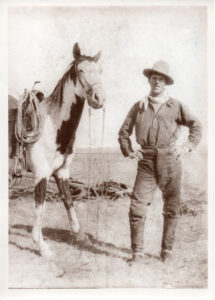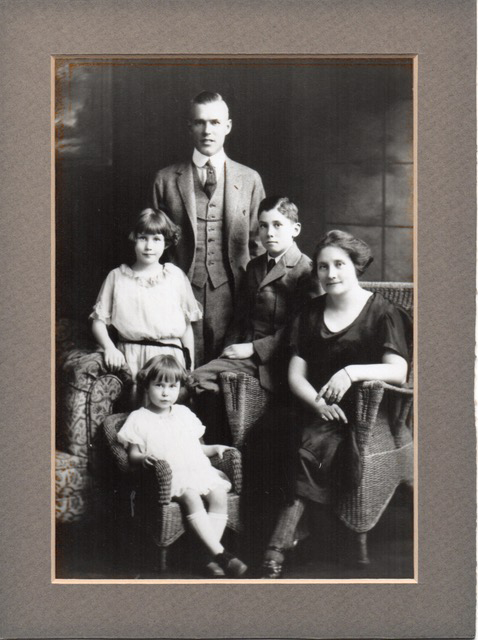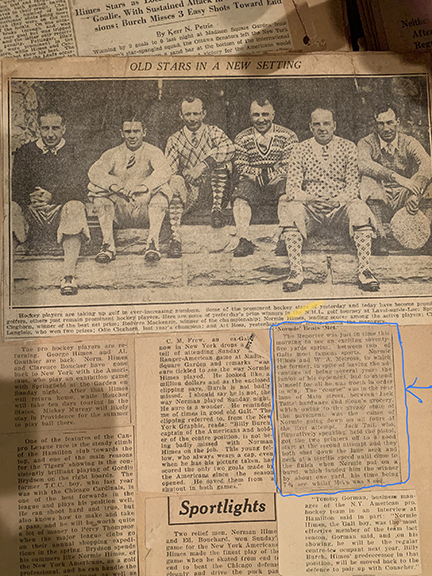
When oldtimers in the mid-1900s gathered to talk about Galt’s greatest athlete, the name Ainslie Melross invariably entered the discussion, right up there with Normie Himes, who was later named Cambridge’s athlete of the twentieth century by the Cambridge Sports Hall of Fame.
Like Himes, Melross was an all-around athlete, excelling in both hockey and lacrosse, among other things.
Ainslie was the fifth of seven children—his brother James evidently died during the San Francisco earthquake—born to James (1850-1901) and Hannah (Evans 1853-1918) Melross. James was a native of Glasgow, Lanark, Scotland, who ran the “Scotch House” dry goods store on Main Street, which he established in September, 1886, a dozen years after arriving in Canada. The store was two stories in height and situated in the heart of downtown Galt, with a large and well-selected stock of staple and fancy dry goods.
A newspaper article of the day described the store: “In the short time Mr. Melross has been in business in Galt, his trade has wonderfully developed, and now extends throughout the town and surrounding sections of the country, the business comparing favourably with any of the old established houses in town.”
A town councillor in Beeton, Ontario, in Simcoe County before coming to Galt, he employed six people.
Ainslie married Florence Graham. Their grandson, Tony Wight, recalls his mother (Ainslie and Florence’s daughter Gertrude) talking about Normie Himes with respect and admiration.
Melross first travelled west by rail to Calgary as a teen, forsaking Winnipeg, where his father had wanted him to ‘land’ and work.Out west he found work as a cowboy and with AlbertaTel, helping establish a network of rural lines.
Eventually he married Florence Graham of Galt and for a time they lived in a house on Memorial Drive by the Bow River, where Gertrude was born. Ainslie played hockey and lacrosse and worked as a cowboy on the famous Bar U Ranch southwest of Calgary.
Years after he returned to Galt, he and Himes ran a footrace against each other in the alley behind Main Street. Himes was then in his prime. Melross was in his forties.

The race drew enough attention to be included in the next issue of the Reporter, with the headline ‘Normie’ Beats Mel.
“The Reporter was just in time this morning to see an exciting seventy-five yards sprint between two of Galt’s most famous sports, Normie Himes and W.A. Melross, in which the former, in spite of having the advantage of being several years the junior of his opponent, had to extend himself for all he was worth in order to win. The “course” was in the rear lane of Main Street, between Jack Tait’s hardware and Sloan’s grocery, which owing to the greasy state of the pavement, was the cause of Normie going down on all fours at the first attempt. Jack Tait, who figuratively speaking held the pistol, got the two sprinters off to a good start at the second attempt and they both shot down the lane neck and neck at a terrific speed until close to the finish when Normie put on a burst, which landed him the winner by about one yard, his time being 7 3/4 sec., whilst Mel’s was 8 sec.”
Melross’s daughter Gertrude seems to have taken after her father, being active in a variety of sports, including basketball, tennis, skiing and swimming.
The family attended Knox Galt Presbyterian church, like the Himes family.
Melross starred in lacrosse and hockey in the early days, long before the NHL, when lacrosse was a popular spectator sport in Canada.
In Ainslie’s time, the sport was rugged and popular among Canadian boys. Mel left a legacy of stories and feats, wrote Reporter sportswriter Stan Markarian.
“Inactivity never appealed to Mel. Before his death at age 57 in 1944, he had crammed into his life other careers such as that of a polo player, hockey player, cowboy, bronco buster, ranch manager and musician.”

Gifted as a hockey player, his reputation as a lacrosse player with the Calgary Lacrosse Club, perennial winners of the Western Canadian Professional Lacrosse League, spread across western and eastern Canada from his playing days in the west, “a reputation that has remained indelible in the memories of those who played with him and others who witnessed his wizardry.”
In addition to working at the Bar U, he also spent time as on ranches in B.C. and Montana, and competed at rodeos throughout western Canada and the U.S.
He learned to play polo, a sport introduced by wealthy English ranchers—the Prince of Wales bought the ranch adjacent to the Bar U—and became so good that he toured Canada, the Yukon and Mexico playing on Canada’s best teams.
But he also played professional hockey in the winters in Calgary, Medicine Hat, High River and Stetler.
During a hotly contested lacrosse game at Medicine Hat he was severely injured when he took a blow that burst his appendix. The injury almost proved fatal as he developed peritonitis, hovering between life and death. As he recovered, he returned home to Galt.
Once back on his feet, he resumed the sport, playing with the Toronto Lacrosse Club in the Ontario Professional Lacrosse League. But the lure of the west called him back and he took a managerial post at the Bar U, and continued his hockey and lacrosse careers.

Following the Great War he returned with his growing family to Galt, settling down to a career in real estate and insurance—he also sold homes in the early days of the Forest Hill Village, which later amalgamated with Toronto—and joined the Hamilton Tigers Lacrosse Club which won the Ontario Professional League title. Among his teammates was Preston’s A. Anderson, as well as two others who gained renown in hockey circles—Hap Day, and Carson Cooper, both later inducted into the Hockey Hall of Fame.
In Galt he captained the Galt Amity Hockey Club and was a member of the Galt Kiltie Band and trombonist with the HLI Brass Band. His musical talents took him on tour in Ontario with several dance orchestras, which he later directed.
Back home in Galt, after his professional playing days were done, he played with teams in Kitchener and Hespeler, where his teammates included three future mayors of Hespeler—William S. Mcvittie, Jack Courtney and Allan Wilford. By then, he was by far the oldest member of the team, but his teammates praised his skills. “He had silver hair but he still was the best player on the team,” said McVittie. “He knew how to handle the ball and was an excellent receiver.”
But he also mentored the younger players, teaching them how to play. Said Courtney: “He was a super athlete, fast as a greyhound.” He was characterized as a player who scored lots of goals but took few penalties. “He loved the game and was a gentleman too.”
Another teammate, Lloyd ‘Toots’ Sudden, said Melross was the hardest working man on the team. “He ran like a deer and few caught him.”
He lived at 42 Blenheim Road (formerly the Galt Old Ladies Home) after having resided on Melville Street during the Depression, where his daughters Gertrude and Joyce shared a single pair of dancing shoes and utilized their baking skills door to door to help the family survive. Once, when a deer escaped from the old animal pens at Galt’s Victoria Park, not far from the Melross home on Blenheim, Melross was able to use his cowboy skills to good advantage, lassooing the stray deer.
Years later, when his son Graham was on a business trip to his birthplace in Calgary, an elderly man remarked that he once knew “a fantastic lacrosse player named Ainslie Melross. Perchance, are you related?”
Melross, one of the city’s greatest athletes, is buried with his wife at Mount View.
